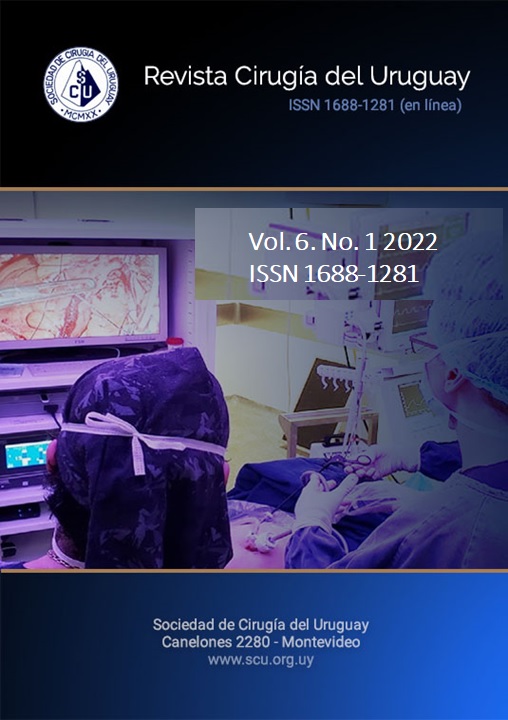Neoplasia papilar intraductal de la vía biliar
DOI:
https://doi.org/10.31837/cir.urug.6.1.10Palabras clave:
neoplasmas, colangiocarcinoma, hepatolitiasisResumen
La neoplasia papilar intraductal de la vía biliar (NPIVB) es una entidad infrecuente caracterizada por el crecimiento exofítico papilar del epitelio biliar hacia la luz ductal. Previamente incluida en el grupo de tumores del mismo nombre de localización pancreática, presenta diferencias evidentes con ellos y desde 2010 se considera una entidad propia con demostrado potencial de malignización hacia colangiocarcinoma.
Descargas
Métricas
Citas
Albores-Saavedra J, Henson DE, Sobin LH. The WHO Histological Classification of Tumors of the Gallbladder and Extrahepatic Bile Ducts. A commentary on the second edition. Cancer. 1992 Jul 15;70(2):410-4. doi: 10.1002/1097-0142(19920715)70:2<410::aid-cncr2820700207>3.0.co;2-r.
Nakanuma Y, Kakuda Y, Uesaka K, Miyata T, Yamamoto Y, Fukumura Y, et al. Characterization of intraductal papillary neoplasm of bile duct with respect to histopathologic similarities to pancreatic intraductal papillary mucinous neoplasm. Hum Pathol. 2016;51:103-13. doi: 10.1016/j.humpath.2015.12.022.
Wan XS., Xu YY., Qian JY., Yang XB., Wang AQ, He L, et al. Intraductal papillary neoplasm of the bile duct. World J Gastroenterol. 2013;19:8595-604. doi: 10.3748/wjg.v19.i46.8595.
Rocha FG, Lee H, Katabi N, DeMatteo R, Fong Y, D’Angelica M, et al. Intraductal papillary neoplasm of the bile duct: A biliary equivalent to intraductal papillary mucinous neoplasm of the pancreas?. Hepatology. 2012;56:1352-60. doi: 10.1002/hep.25786.
Ohtsuka M, Shimizu H, Kato A, Yoshitomi H, Furukawa K, Tsuyuguchi T, et al. Intraductal papillary neoplasms of the bile duct. Int J Hepatol. 2014;2014:459091. doi: 10.1155/2014/459091
Egri C, Yap WW, Scudamore CH, Webber D, Harris A. Intraductal papillary neoplasm of the bile duct: Multimodality imaging appearances and pathological correlation. Can Assoc Radiol J. 2017;68:77-83. doi: 10.1016/j.carj.2016.07.005.
Kim WJ, Hwang S, Lee YJ, Kim KH, K.M. Park, C.S. Ahn, et al. Clinicopathological features and long-term outcomes of intraductal papillary neoplasms of the intrahepatic bile duct. J Gastrointest Surg. 2016;20:1368-75. doi: 10.1007/s11605-016-3103-5
Kloek JJ, van der Gaag NA, Erdogan D, Rauws EA, Busch OR, Gouma DJ, et al. A comparative study of intraductal papillary neoplasia of the biliary tract and pancreas. Hum Pathol, 2011;42:824-32. doi: 10.1016/j.humpath.2010.09.017
Hwang S, Lee YJ, Song GW, Park KM, Kim KH, Ahn CS, et al. Prognostic impact of tumor growth type on 7th AJCC staging system for intrahepatic cholangiocarcinoma: A single-center experience of 659 cases. J Gastrointest Surg. 2015;19:1291-304. doi: 10.1007/s11605-015-2803-6.
Luvira V, Pugkhem A, Bhudhisawasdi V, Pairojkul C, Sathitkarnmanee E, Luvira V, et al. Long-term outcome of surgical resection for intraductal papillary neoplasm of the bile duct. J Gastroenterol Hepatol. 2017;32:527-33
Publicado
Cómo citar
Número
Sección
Licencia
Derechos de autor 2022 Ángel Pierini, Leandro Pierini, Guillermo Ruiz, Brian Evans Rhys, Juan Pablo Elias, Rodrigo Meneghini

Esta obra está bajo una licencia internacional Creative Commons Atribución-NoComercial 4.0.
Los autores conservan sus derechos de autor y ceden a la revista el derecho de primera publicación de su obra, el cuál estará simultaneamente sujeto a la licencia Creative Commons Reconocimiento 4.0 Internacional License. que permite compartir la obra siempre que se indique la publicación inicial en esta revista.






























